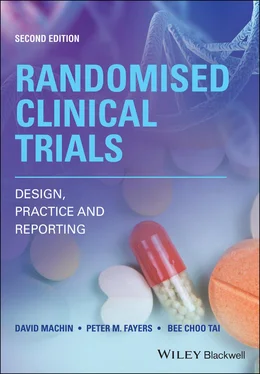Before any trial can take place, individual subjects have to be identified, and formal processes for their consent will have to be instituted. The precise details will depend on the type of trial contemplated, for example, whether it involves an invasive procedure, concerns primary intervention, or has therapeutic intent. Also, if it involves participants such as children, the very elderly, healthy volunteers, the terminally sick or women of fertile age then this may raise particular issues, for example, requiring proxy consent, or reassurance that the trial drugs will not compromise subsequent fertility.
Importantly the patient (or the consent giver) should understand that no‐one knows in advance which therapy will be allocated, and that they should be willing to accept whatever the allocation may be. If they are unwilling, they should not be recruited to the trial.
The ideal is that each patient or volunteer gives fully informed and written consent. However, departures from this will be appropriate in specific circumstances. For example, such departures may concern patients that are unconscious at admission to hospital, patients with hand burns that are so severe that they affect their ability to provide their signature, very young children or those mentally compromised. In these cases, a proxy may consent for them or in the case of those with severe burns witnessed verbal consent may be substituted.
Example 3.25 Protocol SQGL02 (1999): Brimonidine as a neuroprotective agent in acute angle‐closure glaucoma
Before entering patients on the study, clinicians must ensure that the protocol has received clearance from their local Ethics Committees. The patient’s consent to participate in this trial should be obtained after full explanation has been given of the treatment options, including the conventional and generally accepted methods of treatment, and the manner of treatment allocation.
All the possible options on trial should be explained impartially to the patients concerned. This explanation must be provided before the randomisation is realised as knowledge of the assignment may influence the way in which an investigator explains the alternatives. A key feature of the informed consent process is to explain the randomisation procedure and to emphasise that participation is completely voluntary and that the patients can withdraw from the protocol at any time.
As is often the case, new challenges arise and the 2020 COVID‐19 pandemic has had a profound and immediate impact on the conduct of clinical trials. Even without the lockdown and the introduction of circuit breaker in place, due to the infectious nature of the corona virus, it was deemed that the risks would be too high to continue with research activities requiring face‐to‐face contact. As a consequence, in a proposed cluster randomised trial to be conducted in Singapore on the safety and efficacy of hydroxychloroquine in households with index COVID‐19 cases, the study team proposed to contact those concerned via telephone to assess their interest to participate in the clinical trial. At the same time, the email address of the household contact would be obtained. Once the eligible participant had ample time to read the electronic informed consent form (e‐ICF), the study team would conduct the informed consent discussion via video consultation. If the subject then wished to take part in the trial, he/she would be required to digitally sign the e‐ICF using Docusign, in the presence of an impartial witness during the video consenting process.
Example 3.26 eConsent – acute stroke
Haussen, Doppelheuer, Schindler, et al . (2017) describe the use of an electronic consent (e‐Consent) tool to facilitate the informed consent process in trials involving patients with acute ischemic stroke. Because of impairment of language and cognitive status in these patients, the requirement of a physical signature of a legally authorised representative during the consent taking process hinders patient enrolment. The use of e‐Consent was first piloted in a trial of patients, with large vessel occlusion stroke. Eligible patients, who presented within 6–24 hours of last seen as normal, were randomised to either stent‐retriever thrombectomy or best medical therapy. Although the trial commenced recruitment in January 2015, the process of e‐Consent was only approved by the institutional review board in December 2016, 2 months before enrolment to the trial ended in February 2017.
3.12 Organisational structure
The contents of this section will depend to a large extent on the size and complexity of the design of the trial. For example, protocol SQCP01 (2000) involves only two clinical centres but different countries with very different first languages, and which are geographically quite distant. Because this trial is organisationally complex, and involves many clinical disciplines, including specialists in surgery, orthodontics, and speech therapy each with roles to enact over a very long period of 17 or more years, keeping track of the individuals concerned is a major challenge. However, each centre has long experience of dealing with such complex issues so the protocol runs with four named craniofacial/plastic surgeons, four orthodontic coordinators, three speech therapy coordinators and two research coordinators. At the statistical centre a medical statistician and clinical project coordinator are designated to the trial. The protocol contains full names, addresses, telephone, fax and email addresses of these individuals. As may imagined, the actual individuals concerned will no doubt change as the trial progresses forward in time.
In contrast, the SQNP01 (1997) was conducted within a single centre and three clinical coordinators were identified, one representing radiation oncology, the other two medical oncology. The conduct of this trial reflected the day‐to‐day management practices of the centre concerned. At the statistical centre, a medical statistician was designated and a nurse coordinator had shared responsibilities for the trial within both the statistical centre and the clinic from where the patients were recruited. The protocol contains full names, addresses, telephone, fax and email addresses of these individuals.
In situations where the demands of a trial are somewhere between these two extremes, the protocol development team must ensure that the necessary organisational structure is in place and each component thereof knows of their individual responsibilities. One important role of the trial office is to help maintain this functionality throughout the life of the trial.
If at all possible, the protocol should fit as closely as possible within the confines of current practice in the centres concerned, with the proviso that the aims of the trial are not compromised by so doing. This facilitates acceptance of what is new in the protocol from the local team and thereby should help with the smooth running of the trial and hopefully maximise recruitment rates.
In most clinical trial groups, there will inevitably be several members of the team and should the trial be multicentre then the full team of collaborators may be very numerous. It is useful to have stipulated a clear policy as to who the authors of the final publication will be and in what order they appear on the title page. Provided this is clear, and agreed by all concerned (including latecomers to the trial once it is ongoing) this need not be in included in the protocol itself. If a large number of collaborators are involved then it may be more sensible to publish under a group name with a full list of the investigators included as an appendix to the report but again, this should have been discussed and agreed from the outset.
Читать дальше












